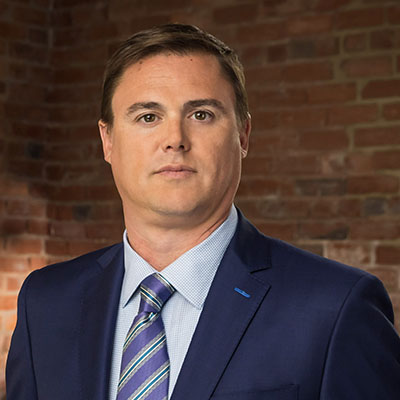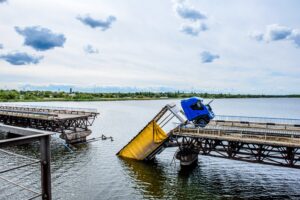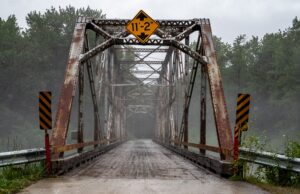The fatal bridge collapse in Baltimore has brought a renewed focus on the state of bridges across the U.S. Virginia’s rankings are a cause for concern.
According to a report from the American Road and Transportation Builders Association, Virginians are driving across bridges in “poor” or worse condition more than 2.2 million times a day.

How many bridges in Virginia are in poor or worse condition?
It has been determined that 498 Virginia bridges are in poor or worse condition. This encompasses 3.5% of Virginia’s 14,000+ bridges. What’s more, is that at least 52 bridges in Virginia have been in poor condition for more than a decade, according to data from the National Bridge Inventory.
Are there any Richmond bridges in poor condition?
Unfortunately, 14 of the questionable bridges are located in the Richmond region. Eight of the 14 bridges were built before the 1930s, and nearly half the bridges will soon be entering the 50-year mark. This is when they will need to be repaired or replaced, according to a report from the transportation research nonprofit TRIP.
Some of Richmond bridges in question include:
- Chesterfield: I-95 over Route 606 (Reymet Rd)
- Richmond: 5th street ramp over I-95
- Henrico: John Tyler Memorial Highway over Turkey Island Creek
- Richmond: Arthur Ashe Blvd over CSX railroad
- Chesterfield: Huguenot Road over Little Westham Creek
- Henrico: Route 0195 over Route 197 & CSX Transportation railroad
- Richmond: Cary Street over Route 195 & CSX Transportation
- Henrico: NBL I-95 over CSX Transportation
- Richmond: Broad Street over I-95
- Henrico: New Osbourne Turnpike over Almond Creek
- Richmond: Broad Street over CSZ Abandoned Spur Line
- Henrico: Laburnum Ave over Highway 64
- Richmond: North Boulevard over CSX Railway
- Henrico: Parham Road at CSX railway (close to Woodman)
How often do bridges collapse without warning in the U.S.?
The numbers don’t lie: From 1960 to 2015, there have been 35 major bridge collapses worldwide, with 342 people killed. The United States accounted for 18 out of those 35 collapses, per the World Association for Waterborne Transport Infrastructure.
Granted, these numbers reflect collapses due to ship or barge collisions, but when a bridge is in good condition, it is less likely to be taken down by a watercraft. Aging beams and weakened piers will compromise a bridge struck by a boat.
Unfortunately, some bridges are collapsing on their own. One example is the 2022 bridge collapse over Fern Hollow Creek in Pittsburgh. Federal investigators determined the bridge’s steel legs had corroded, creating visible holes. Yet inspectors failed to calculate the severity of the problem and the city failed to follow repeated recommendations. “This bridge didn’t collapse just by an act of God. It collapsed because of a lack of maintenance and repair,” National Transportation Safety Board member Michael Graham said.
Thirteen people died and 145 others were injured when an Interstate 35 bridge collapsed over the Mississippi River in Minneapolis in 2007. Loss of life is the biggest tragedy from these incidents, but not the only one. Local economies take a big hit when bridges collapse. Baltimore had to close its port for a time, and many businesses (including cruise lines) have had to move their ships to alternate ports. Closed bridges in Providence, Rhode Island and Tacoma, Washington are hurting the economy, with some local businesses seeing a 20% drop in revenue.
Is there any good news about bridges in Virginia?
On the bright side, having 3.5% of bridges in poor condition is still a lower rate than the national average of 6.8%. In fact, Virginia has a better rate than 39 other states. West Virginia has the highest rate, at 20%.
One-third of our bridges are in good condition, and about 63% of our bridges are in fair condition.
Importantly, a bridge in “poor” condition doesn’t necessarily mean that it’s unsafe or about to collapse. According to the Virginia Department of Transportation, if a bridge is placed in “poor” condition, it is inspected annually, then placed on a priority list for repairs or replacement. And in general, fewer bridges are in need of repair now than in 2019. Virginia does need to tend to 6,346 bridges at the moment, but a few years ago that number was over 100 higher, at 6,455. This indicates that we are catching up on the work that needs to be done, albeit slowly.
What’s next for bridges in Virginia?
The Commonwealth will receive nearly $600,000,000 from the Infrastructure Investment and Jobs Act. This will take place over a five-year period, in which bridges will be replaced and repaired.
Bridge collapses and personal injury lawsuits
When a bridge collapses due to the negligence of local governments meant to maintain public safety, tragedy ensues for the taxpayers who contributed toward the infrastructure that failed them.
Naturally, victims of the Fern Hollow Bridge collapse filed lawsuits. They accused the city of Pittsburgh and engineering inspection companies of negligence, as they failed to maintain the bridge and perform proper inspections, leading to the collapse. The tragic bridge collapse in Minneapolis led to a flurry of lawsuits. The final lawsuit settled for $52.4 million.
Catastrophic injuries and wrongful death are not easy burdens to shoulder. Holding the negligent parties responsible is not only fair to those who have suffered through no fault of their own, but it creates awareness and sets a standard. Lawsuits force local governments and engineering companies to be more responsible and adhere to best practices for the safety of their communities.
I have been injured in a bridge collapse. What should I do?
This post shares many resources and lists for troubled bridges across the state. While we have been assured of our safety by local governments, we also know that there have been catastrophic failures. If you or a loved one have been injured by a bridge collapse or other faulty infrastructure issue, call the experienced personal injury attorneys at Allen & Allen. We can help you navigate the legalities of your case, so that you can focus on healing. For a free case evaluation, call us today, at 866-308-1307. We’re here to help.







